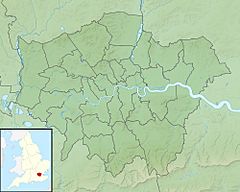Finchley Gap facts for kids
The Finchley Gap or Finchley deposits are an array of trace glacial remnants at and at points south of the foot of the Grim's Ditch spanning the breadth of North London. Evidence gathered in the 1980s dispelled the notion of this zone being a wind gap, left by a brief or long flow of the Colne (which today flows west, then south), while confirming its upper course once flowed north-east then east across the Vale of St Albans to reach the Lea Valley at Hertford.
Context
On the upper Thames the Goring Gap, a former dip between high hills saw pooling before it – due to glaciation across (blockage to) its northern, shared lower course – the Great Ouse ‐ an icing up of the Vale of Aylesbury. Thus the geologically early upper Thames flowed by a reversed Thame through what today is low, broad wind valley. Some pooling there may well have added to flows of the River Gade and/or River Chess in a later ice age into the deep valley of the uppermost Colne, which ran reversed (west-east) towards the River Lea (or Lee). Later, as cold increased, this channel was blocked by the large ice sheet over Hertfordshire and most of Essex. The Anglian glaciation reached its peak centuries. With its path blocked by ice the river would have ponded back to a periglacial lake. This would have eventually overflowed, wending a new path and valley to the essentially parallel river valley fed by the Kennet and Loddon (the middle or lower Thames).
Any flow along the Finchley gap or spring line was impeded by Anglian glaciation across most or all of Middlesex. Thus the rivers Crane and Ash flow south then east and many southward channels of the lower Colne formed, all to augment the existing separate large river, that is, the modern course of the lower Thames.
Evidence
Evidence of glaciation was extensively gathered by Professor Sidney Wooldridge (1938 and 1960), who dated it to the Anglian Stage glaciation around 450,000 BCE. This left telltale freeze-thaw and boulder clays by valleys as far as Bricket Wood in the northwest, Finchley in the west and Hornchurch at London's east extreme to the southeast.
The deposits reflect the erosion southward during the Quaternary ice age when the northern land was blocked by ice and moraines.
Finchley gap, as a minor rivers connection
Wooldrige suggested the Colne, forced into reverse may have somehow found away to link to the Brent
Dispelling of Finchley gap
Later work matched gravel deposits in the Vale of St Albans with those in the modern lower Thames valley. This suggests that the Finchley overflow route is unlikely and – once ponded back from Rickmansworth by the ice – the formative Colne overflowed more directly into its current route.
The Mutton Brook, Dollis Brook, River Brent channels are more likely to have been cut by melt waters from the lobe of glacial ice that occupied Finchley when the ice sheets were at their maximum extent.


